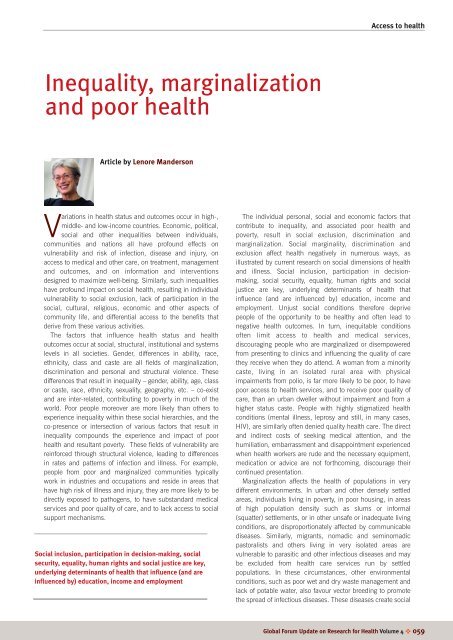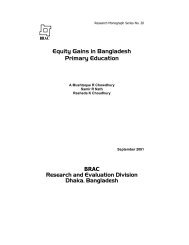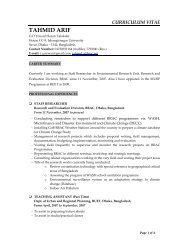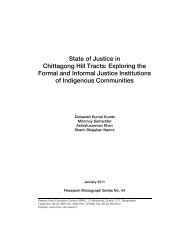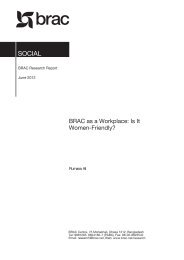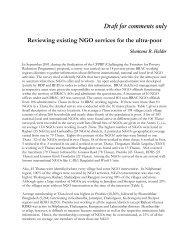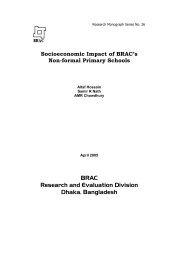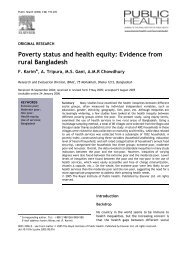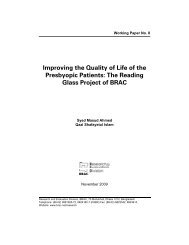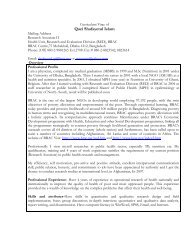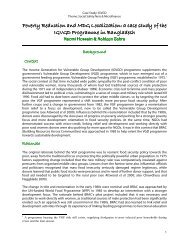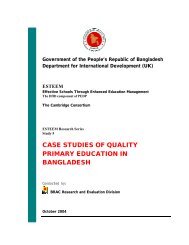Combining health and social protection measures to reach the ultra ...
Combining health and social protection measures to reach the ultra ...
Combining health and social protection measures to reach the ultra ...
Create successful ePaper yourself
Turn your PDF publications into a flip-book with our unique Google optimized e-Paper software.
Access <strong>to</strong> <strong>health</strong><br />
Inequality, marginalization<br />
<strong>and</strong> poor <strong>health</strong><br />
Article by Lenore M<strong>and</strong>erson<br />
Variations in <strong>health</strong> status <strong>and</strong> outcomes occur in high-,<br />
middle- <strong>and</strong> low-income countries. Economic, political,<br />
<strong>social</strong> <strong>and</strong> o<strong>the</strong>r inequalities between individuals,<br />
communities <strong>and</strong> nations all have profound effects on<br />
vulnerability <strong>and</strong> risk of infection, disease <strong>and</strong> injury, on<br />
access <strong>to</strong> medical <strong>and</strong> o<strong>the</strong>r care, on treatment, management<br />
<strong>and</strong> outcomes, <strong>and</strong> on information <strong>and</strong> interventions<br />
designed <strong>to</strong> maximize well-being. Similarly, such inequalities<br />
have profound impact on <strong>social</strong> <strong>health</strong>, resulting in individual<br />
vulnerability <strong>to</strong> <strong>social</strong> exclusion, lack of participation in <strong>the</strong><br />
<strong>social</strong>, cultural, religious, economic <strong>and</strong> o<strong>the</strong>r aspects of<br />
community life, <strong>and</strong> differential access <strong>to</strong> <strong>the</strong> benefits that<br />
derive from <strong>the</strong>se various activities.<br />
The fac<strong>to</strong>rs that influence <strong>health</strong> status <strong>and</strong> <strong>health</strong><br />
outcomes occur at <strong>social</strong>, structural, institutional <strong>and</strong> systems<br />
levels in all societies. Gender, differences in ability, race,<br />
ethnicity, class <strong>and</strong> caste are all fields of marginalization,<br />
discrimination <strong>and</strong> personal <strong>and</strong> structural violence. These<br />
differences that result in inequality – gender, ability, age, class<br />
or caste, race, ethnicity, sexuality, geography, etc. – co-exist<br />
<strong>and</strong> are inter-related, contributing <strong>to</strong> poverty in much of <strong>the</strong><br />
world. Poor people moreover are more likely than o<strong>the</strong>rs <strong>to</strong><br />
experience inequality within <strong>the</strong>se <strong>social</strong> hierarchies, <strong>and</strong> <strong>the</strong><br />
co-presence or intersection of various fac<strong>to</strong>rs that result in<br />
inequality compounds <strong>the</strong> experience <strong>and</strong> impact of poor<br />
<strong>health</strong> <strong>and</strong> resultant poverty. These fields of vulnerability are<br />
reinforced through structural violence, leading <strong>to</strong> differences<br />
in rates <strong>and</strong> patterns of infection <strong>and</strong> illness. For example,<br />
people from poor <strong>and</strong> marginalized communities typically<br />
work in industries <strong>and</strong> occupations <strong>and</strong> reside in areas that<br />
have high risk of illness <strong>and</strong> injury, <strong>the</strong>y are more likely <strong>to</strong> be<br />
directly exposed <strong>to</strong> pathogens, <strong>to</strong> have subst<strong>and</strong>ard medical<br />
services <strong>and</strong> poor quality of care, <strong>and</strong> <strong>to</strong> lack access <strong>to</strong> <strong>social</strong><br />
support mechanisms.<br />
Social inclusion, participation in decision-making, <strong>social</strong><br />
security, equality, human rights <strong>and</strong> <strong>social</strong> justice are key,<br />
underlying determinants of <strong>health</strong> that influence (<strong>and</strong> are<br />
influenced by) education, income <strong>and</strong> employment<br />
The individual personal, <strong>social</strong> <strong>and</strong> economic fac<strong>to</strong>rs that<br />
contribute <strong>to</strong> inequality, <strong>and</strong> associated poor <strong>health</strong> <strong>and</strong><br />
poverty, result in <strong>social</strong> exclusion, discrimination <strong>and</strong><br />
marginalization. Social marginality, discrimination <strong>and</strong><br />
exclusion affect <strong>health</strong> negatively in numerous ways, as<br />
illustrated by current research on <strong>social</strong> dimensions of <strong>health</strong><br />
<strong>and</strong> illness. Social inclusion, participation in decisionmaking,<br />
<strong>social</strong> security, equality, human rights <strong>and</strong> <strong>social</strong><br />
justice are key, underlying determinants of <strong>health</strong> that<br />
influence (<strong>and</strong> are influenced by) education, income <strong>and</strong><br />
employment. Unjust <strong>social</strong> conditions <strong>the</strong>refore deprive<br />
people of <strong>the</strong> opportunity <strong>to</strong> be <strong>health</strong>y <strong>and</strong> often lead <strong>to</strong><br />
negative <strong>health</strong> outcomes. In turn, inequitable conditions<br />
often limit access <strong>to</strong> <strong>health</strong> <strong>and</strong> medical services,<br />
discouraging people who are marginalized or disempowered<br />
from presenting <strong>to</strong> clinics <strong>and</strong> influencing <strong>the</strong> quality of care<br />
<strong>the</strong>y receive when <strong>the</strong>y do attend. A woman from a minority<br />
caste, living in an isolated rural area with physical<br />
impairments from polio, is far more likely <strong>to</strong> be poor, <strong>to</strong> have<br />
poor access <strong>to</strong> <strong>health</strong> services, <strong>and</strong> <strong>to</strong> receive poor quality of<br />
care, than an urban dweller without impairment <strong>and</strong> from a<br />
higher status caste. People with highly stigmatized <strong>health</strong><br />
conditions (mental illness, leprosy <strong>and</strong> still, in many cases,<br />
HIV), are similarly often denied quality <strong>health</strong> care. The direct<br />
<strong>and</strong> indirect costs of seeking medical attention, <strong>and</strong> <strong>the</strong><br />
humiliation, embarrassment <strong>and</strong> disappointment experienced<br />
when <strong>health</strong> workers are rude <strong>and</strong> <strong>the</strong> necessary equipment,<br />
medication or advice are not forthcoming, discourage <strong>the</strong>ir<br />
continued presentation.<br />
Marginalization affects <strong>the</strong> <strong>health</strong> of populations in very<br />
different environments. In urban <strong>and</strong> o<strong>the</strong>r densely settled<br />
areas, individuals living in poverty, in poor housing, in areas<br />
of high population density such as slums or informal<br />
(squatter) settlements, or in o<strong>the</strong>r unsafe or inadequate living<br />
conditions, are disproportionately affected by communicable<br />
diseases. Similarly, migrants, nomadic <strong>and</strong> seminomadic<br />
pas<strong>to</strong>ralists <strong>and</strong> o<strong>the</strong>rs living in very isolated areas are<br />
vulnerable <strong>to</strong> parasitic <strong>and</strong> o<strong>the</strong>r infectious diseases <strong>and</strong> may<br />
be excluded from <strong>health</strong> care services run by settled<br />
populations. In <strong>the</strong>se circumstances, o<strong>the</strong>r environmental<br />
conditions, such as poor wet <strong>and</strong> dry waste management <strong>and</strong><br />
lack of potable water, also favour vec<strong>to</strong>r breeding <strong>to</strong> promote<br />
<strong>the</strong> spread of infectious diseases. These diseases create <strong>social</strong><br />
Global Forum Update on Research for Health Volume 4 ✜ 059


